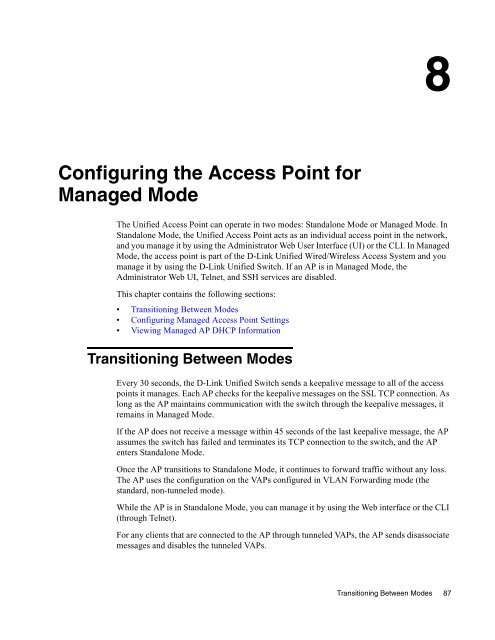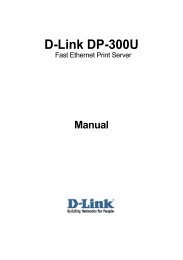Unified Access Point (AP) Administrator's Guide
Unified Access Point (AP) Administrator's Guide
Unified Access Point (AP) Administrator's Guide
Create successful ePaper yourself
Turn your PDF publications into a flip-book with our unique Google optimized e-Paper software.
Configuring the <strong>Access</strong> <strong>Point</strong> for<br />
Managed Mode<br />
8<br />
The <strong>Unified</strong> <strong>Access</strong> <strong>Point</strong> can operate in two modes: Standalone Mode or Managed Mode. In<br />
Standalone Mode, the <strong>Unified</strong> <strong>Access</strong> <strong>Point</strong> acts as an individual access point in the network,<br />
and you manage it by using the Administrator Web User Interface (UI) or the CLI. In Managed<br />
Mode, the access point is part of the D-Link <strong>Unified</strong> Wired/Wireless <strong>Access</strong> System and you<br />
manage it by using the D-Link <strong>Unified</strong> Switch. If an <strong>AP</strong> is in Managed Mode, the<br />
Administrator Web UI, Telnet, and SSH services are disabled.<br />
This chapter contains the following sections:<br />
Transitioning Between Modes<br />
Configuring Managed <strong>Access</strong> <strong>Point</strong> Settings<br />
Viewing Managed <strong>AP</strong> DHCP Information<br />
Transitioning Between Modes<br />
Every 30 seconds, the D-Link <strong>Unified</strong> Switch sends a keepalive message to all of the access<br />
points it manages. Each <strong>AP</strong> checks for the keepalive messages on the SSL TCP connection. As<br />
long as the <strong>AP</strong> maintains communication with the switch through the keepalive messages, it<br />
remains in Managed Mode.<br />
If the <strong>AP</strong> does not receive a message within 45 seconds of the last keepalive message, the <strong>AP</strong><br />
assumes the switch has failed and terminates its TCP connection to the switch, and the <strong>AP</strong><br />
enters Standalone Mode.<br />
Once the <strong>AP</strong> transitions to Standalone Mode, it continues to forward traffic without any loss.<br />
The <strong>AP</strong> uses the configuration on the V<strong>AP</strong>s configured in VLAN Forwarding mode (the<br />
standard, non-tunneled mode).<br />
While the <strong>AP</strong> is in Standalone Mode, you can manage it by using the Web interface or the CLI<br />
(through Telnet).<br />
For any clients that are connected to the <strong>AP</strong> through tunneled V<strong>AP</strong>s, the <strong>AP</strong> sends disassociate<br />
messages and disables the tunneled V<strong>AP</strong>s.<br />
Transitioning Between Modes 87
















